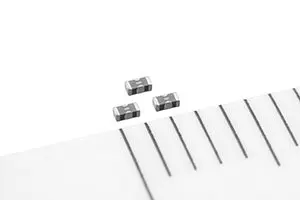source: TDK news
Mar. 7, 2017. TDK Corporation presents the MEM1005PP251T – a new LC filter for EMI suppression. With dimensions of just 1.0 x 0.5 x 0.35 mm the filters are ideally suited for use in smart phones and base stations. Volume production began in March 2017.
The usual method for suppressing interference in the communication frequency bands of smart phones and other devices is to use capacitors or inductances, or a combination of these components. In contrast to discrete solutions, the MEM1005PP251T combines two capacitors and an inductance in the form of a Pi filter in a single component. As a result, 61 percent less space is required and there is a reduction in the overall number of components.
Thanks to the special design by TDK, the component offers very low-loss operation and a DC resistance of just 0.8 Ω, which represents a reduction of 69 percent when compared to previous products. The new filter offers a rated current of 350 mA, which is 3.5 times more than the MEM1608P series. With these properties the combination element offers the highest possible performance currently available in its class.* In addition, the new filter is designed for a very wide temperature range from -55 °C to +125 °C, whereas previous series only covered the range from -40 °C to +85 °C. Due to expansion of rated current and the wide temperature range, it allows a high degree of design flexibility.
The attenuation in the frequency range from 700 MHz to 3 GHz, which is used by mobile communications, is in excess of 30 dB. This means that interference is extremely well suppressed and the reception sensitivity increases significantly.
In future, TDK will extend this product line to meet the design requirements for a broad spectrum of devices for wireless communication.
*Status: March 2017 according to studies by TDK
Main applications
- Smart phones, Tablet PCs and game consoles with communication function equipped
- Base stations
Main features and benefits
- High degree of noise suppression of over 30 dB in the mobile radio frequency range
- Significant increase in the reception sensitivity of communication equipment
- Footprint reduced by 61 percent compared to existing products and reduction of implementation cost
- Low DC resistance and therefore low loss
- High flexibility of design thanks to high permissible rated current
Key data
| Type | Cutoff frequency [MHz] |
DC impedance [Ω] |
Rated current [mA] | Maximum voltage [V] |
|---|---|---|---|---|
| MEM1005PP251T | 250 typ. | 0.8 max. | 350 max. | 10 |


































